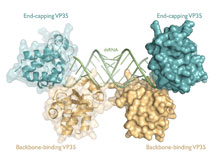

Scientists Reveal Key Structure from Ebola Virus
Scientists at The Scripps Research Institute have determined the structure of a critical protein from the Ebola virus, which, though rare, is one of the deadliest viruses on the planet killing between 50 and 90 percent of those infected. Described in an online Early Edition of the journal Proceedings of the National Academy of Sciences (PNAS) on December 14, 2009, the research reveals how a key component of the Ebola virus, called VP35, blocks the human immune system, allowing the virus uncontrolled replication. The structure represents a major step forward in understanding how the deadly virus works, and may be useful in the development of potential treatments for those infected.
"After infection, the virus and immune system are in a race," said Erica Ollmann Saphire, associate professor at Scripps Research, who led the three-year effort to solve the structure. "If the virus can hide its molecular signatures, it can suppress immune responses and replicate unchecked. This new understanding of the mechanism that Ebola virus uses to evade the immune system opens the door for developing drug therapies."
A signature of Ebola virus infection is the presence of the virus's double-stranded RNA, which, when detected by immune system proteins, triggers a full immune response. The new research describes how the VP35 protein of the Ebola virus masks the double-stranded RNA to prevent the immune response.
The protein structure, determined by X-ray crystallography, showed that VP35 binds another copy of itself, and the pair cooperatively masks the RNA ends. Graduate student Christopher Kimberlin, the first author of this study, explained that this assembly is unusual because each member of the pair binds the RNA in a different way, revealing that VP35 has two unique strategies for masking viral signatures. Importantly, the interface between the two VP35 molecules provides a new target for drugs that would stop Ebola virus infection and allow the immune system to clear the infection. Additional RNA binding, small angle X-ray scattering, and deuterium exchange mass spectrometry experiments confirm the cooperative function of these molecules for immunosuppression.
There is currently no cure for Ebola hemorrhagic fever. The virus is spread when people come into contact with the bodily fluids of an infected person or animal. Most die from a combination of dehydration, massive bleeding, and shock. There is currently no vaccine or drug therapy for Ebola infection, but the findings of this study may lead to new treatments.
The article, "Ebolavirus VP35 uses a bimodal strategy to bind dsRNA for innate immune suppression," was authored by Christopher Kimberlin, Zachary Bornholdt, Ian MacRae, and Erica Ollmann Saphire of The Scripps Research Institute in collaboration with Sheng Li and Virgil Woods, Jr. of the University of California San Diego. For more information, see http://www.pnas.org/content/early/2009/12/10/0910547107.abstract.
Support for the research was provided by grants from the National Institutes of Health, a Career Award from the Burroughs Wellcome Fund, and The Skaggs Institute for Chemical Biology.
Send comments to: mikaono[at]scripps.edu

The new research reveals how a key component of the Ebola virus, called VP35, blocks the human immune system, allowing the virus uncontrolled replication. (Image by Christopher Kimberlin.) Click for details.
